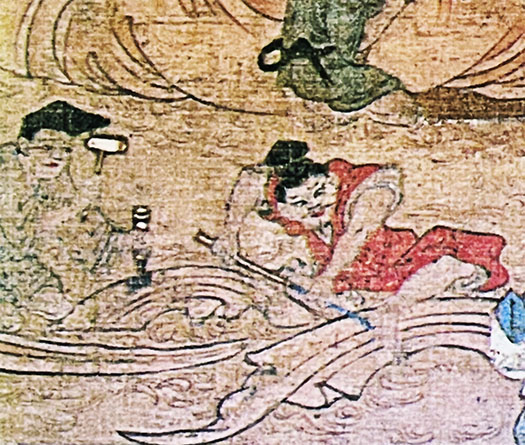

聖徳太子絵伝とは聖徳太子一代の伝記を絵画化したもの。
古くは奈良後期に四天王寺絵堂に太子絵伝の壁画があったことが文献からわかる。
現存中最古の遺品は1069年旧法隆寺絵殿の障子絵(国宝。東京国立博物館)で、
秦致真(はたのちしん)の作と知られる。後世の補修が何度か加えられているが、
画面構成や図様は当初の模様を伝え、平安時代の作者・制作年の明らかな遺品。
鎌倉時代以降、太子信仰隆盛とともに絵巻や掛幅などに数多くの絵伝がつくられた。
で、わたしが見たのはこの飛鳥寺での寺宝の陳列。
タイトルとして「推古天皇の勅命を奉じ仏像制作に励む鞍作止利」とある。
画像から見るとこの飛鳥寺の本尊、飛鳥大仏とは別だと思われる。
法隆寺にも伝鞍作止利作という国宝作品があり、
一連のかれの作品の内のどれかをモデルとしたものでしょう。
この制作過程では木彫工程が描かれていて、金属製の大仏制作工程の
前段階の様子をわかりやすく見せたものなのでしょうか。
日本社会で「メディア」というものはこのような宗教関連事跡を
多くの民人に「広報普及させる」目的で創始されていった。
聖徳太子信仰という草の根的な「民衆文化」の成立には
このような絵伝、あるいは寺の「縁起もの」が大きな役割を果たしたのだろう。
その延長線上で大好きな「鳥獣戯画」のようなファンタジーを
日本文化は生み出した。すばらしい。
日本で統一国家を生成させるには仏教の普及が大きな役割を果たしたが
民衆に対しての普及啓発手段としてこういうメディアは
きわめて独自の発展を遂げてきたのではないだろうか。
国家の始原の様子をいまに伝えてくれる飛鳥の地からすでに
こういう文化がスタートしていった様子がわかるのだと思う。
仏教普及という大きなテーマに基づいた広報の営為だけれど、
その表現手法に於いて、鳥獣戯画のような突き抜けた独創性の発露も出現する。
他国の文化に比較して日本文化の独自性のルーツがこういった形式だろう。
各寺院がまるで競争するように、こういう広報メディア戦略を推進し、
時代を超えて進化発展を繰り返してきた。
メディアという存在に長く携わり、自分で創始もした経験からすると
常に「もっとわかりやすく、先人を越えていきたい」という
目的意識に導かれていると感じさせられる。
そういうはるかな道程のいまを自分は生きていて、
やがてのちの人々にバトンを渡していくのだとも強く感じる。
この絵伝に描かれた木の職人さんたちの姿と、
それを描いた絵師さんたちの営為を思い浮かべて湧き上がるものがある。
English version⬇
Asuka Historical Testimony-3: The Biography of Prince Shotoku – The Beginning of Japanese Media
Japanese media was born and developed from the spread of Buddhism, which formed the foundation of a unified nation. The following is a brief look at the future of this far-reaching culture. …
Shotoku Taishi E biography is a pictorial biography of the life of Shotoku Taishi.
Literature shows that there was a wall painting of the Taishi picture biography in the picture hall of Shitennoji Temple in the late Nara period (710-794).
The oldest surviving copy is a 1069 shoji-e (sliding door picture) from the former Horyu-ji Temple Picture Hall (National Treasure, kept at the Tokyo National Museum). (National Treasure, kept at the Tokyo National Museum).
It is known to be the work of Hata Chishin. Although repairs have been made several times in later periods
Although several repairs have been made in later periods, the composition of the screen and the design convey the original pattern, and it is valuable as an artifact of the Heian period with a clear author and date of production.
Since the Kamakura period (1185-1333), with the rise of the Taishi faith, many picture scrolls and hanging scrolls have been produced.
I saw this display of temple treasures at Asuka-ji Temple.
The title of the display is “Kurusaku Tadatoshi, who devoted himself to the creation of Buddhist statues at the behest of Emperor Suiko.
From the image, it seems that this is a different statue from the Asuka Daibutsu, the main statue of Asukadera Temple.
Horyuji Temple also has a National Treasure called “Den Kuramasaku Toritoshi” (by Kuramasaku Toritoshi), which is a model of a series of his works.
It is likely modeled after one of his works in the series.
This work depicts the process of wood carving, and clearly shows the preliminary stage of the production process of the metal statue of the Daibutsu.
This work may be an easy-to-understand representation of the preliminary stages in the process of making the metal statue of the Great Buddha.
In Japanese society, the “media” are used to “publicize and disseminate” religious sites such as this to a large number of people.
The “media” in Japanese society was created for the purpose of “publicizing and disseminating” such religious events to a large number of people.
The establishment of a grass-roots “popular culture” of belief in Prince Shotoku was
Such pictorial traditions and temple “lucky charms” must have played a major role in the establishment of the grassroots “popular culture” of Prince Shotoku’s faith.
As an extension of this, Japanese culture produced fantasies such as the “Birds and Beasts Caricatures,” which are a favorite of mine.
Japanese culture has produced fantasies like my favorite “Birds and Beasts Caricatures”. It is wonderful.
The spread of Buddhism played a major role in the creation of a unified nation in Japan.
As a means of spreading awareness among the people, this type of media has developed quite uniquely, hasn’t it?
This kind of media as a means of spreading awareness among the people has developed in its own unique way.
We can already see how this kind of culture started in Asuka, which tells us about the origin of the nation.
The Asuka period, which tells us the origin of the nation, was already the start of this kind of culture.
Although it is a public relations activity based on the major theme of spreading Buddhism
In the method of expression, however, there are also some outlandishly original works such as Birds, Beasts, and Caricatures.
This form of expression is the root of the uniqueness of Japanese culture compared to other cultures.
Temples have been promoting this kind of publicity media strategy as if they were competing with each other, and have continued to evolve and develop over time.
The media has evolved and developed over the ages.
Having been involved in the media for a long time and having created it myself
I have always felt that I am guided by a sense of purpose to “make it easier to understand and surpass our predecessors.
I feel that I am always guided by a sense of purpose, “I want to make things easier to understand and surpass my predecessors.
I am living in the present moment of such a long journey, and I hope to pass the baton to those who will come after me.
I strongly feel that I am living in the present moment of such a long journey, and that I will eventually pass the baton to those who come after me.
The wooden craftsmen depicted in this pictorial biography and the artists who drew them.
I feel something welling up when I think of the wooden craftsmen depicted in this pictorial biography and the activities of the artists who painted them.
Posted on 6月 22nd, 2022 by 三木 奎吾
Filed under: 住宅マーケティング, 日本社会・文化研究







コメントを投稿
「※誹謗中傷や、悪意のある書き込み、営利目的などのコメントを防ぐために、投稿された全てのコメントは一時的に保留されますのでご了承ください。」
You must be logged in to post a comment.